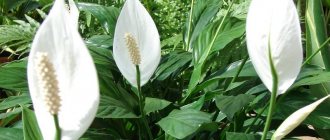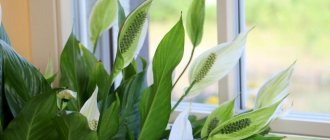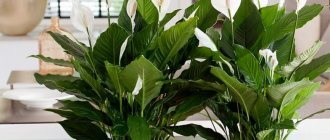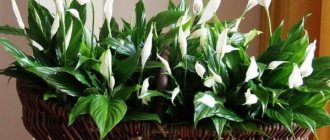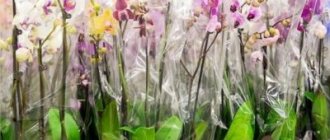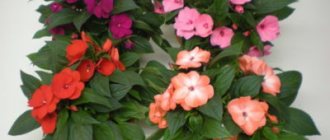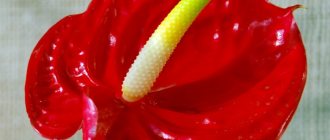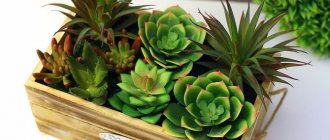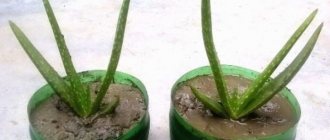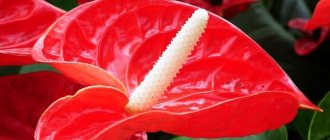What kind of culture is this?
Biological description
Spathiphyllum is a perennial plant, a member of the genus Anthurium.
Appearance
Spathiphyllum is an evergreen plant . It can have different heights from miniature ones of 20 cm to large specimens of one meter. The plant stands out for its spectacular and beautiful flowering.
With good care, some types of spathiphyllum can bloom for almost a whole year.
Read about spathiphyllum organs, diseases and pests of the flower here.
What does it look like in the photo?
Here you can see photographs of the flower of female happiness or spathiphyllum.
Passport
- Light : bright place, light partial shade.
- Temperature : optimal temperature 22-23 degrees.
- Watering : abundant from spring to autumn, more moderate in winter. Does not tolerate stagnation of water in the roots.
- Humidity : needs high humidity.
Country of origin
The birthplace of this plant is considered to be South America, East Asia, and Polynesia. In nature, spathiphyllum grows in damp and warm places : along the banks of rivers and streams, in swampy places. They began to use it as a houseplant only in the 60s of the 20th century.
Read more about who discovered spathiphyllum and what its country of origin is here.
Major organs
Spathiphyllum inflorescences have an unusual shape - in the form of a cob and a white petal growing at the base. The cob itself has different shades depending on the type. The plant has a short rhizome and no stem. The leaves grow directly from the ground and are usually oval in shape with a pointed tip and a prominent midrib. This is typical for tropical areas.
Types and varieties
It is no secret that breeders are constantly working on developing new varieties and types of indoor plants. Therefore, the spathiphyllum flower already has more than 20 varieties that are suitable for growing on windowsills. Caring for spathiphyllum at home is simple and even a beginner can handle all the procedures. Therefore, the future gardener can only choose the appropriate variety from the photo and read a minimum of information about the plant.
Flower growers advise paying attention to unpretentious species, such as spathiphyllum Strauss or Bellini. These varieties are distinguished by long flowering in summer, abundant foliage and strong immunity. Below in the article we describe what the most popular varieties of spathiphyllum look like.
Spathiphyllum cannifolium spathiphyllum cannifolium
This variety of spathiphyllum has beautiful glossy leaf blades of a rich green color. The shape of the leaves is oval, slightly elongated towards the edge. In the center of the leaf there is a well-defined vein with branching lateral veins. The species received its name due to the similarity of the shape of the leaf blades with the canna flower.
The plant of female happiness blooms twice a year, the opened buds have a pleasant, spicy aroma.
Spathiphyllum spoon-shaped spathiphyllum cochlearispathum
Spathiphyllum this variety has long leaves from 31 to 42 cm, which grow from dense petioles one or several pieces at a time. The petioles are strong, rounded, length from 63 to 74 cm. The maximum height of an adult plant does not exceed one meter.
The leaf blades are oval-elongated, with a glossy, bright green surface. The variety blooms in spring and summer. The cob and spathe are snow-white.
Spathiphyllum floribundum
This variety of spathiphyllum is characterized by abundant flowering and a height of 42 to 53 cm. The leaf blades are oblong-oval in shape with a pointed edge, glossy, dark green in color. The central vein is slightly lighter than the main color, therefore more clearly expressed than in other varieties.
One white flower is formed on the peduncle; as it grows, the spathe changes color to greenish.
The size of the bedspread is from 11 to 14 cm, the cream cob is from 18 to 23 cm.
Good to read: Lily is a royal flower, a serious competitor to roses.
Spathiphyllum lovely spathiphyllum blandum
This spathiphyllum differs from others in the shape of its leaf blades. The leaves are oval and elongated at the edges, the edge is slightly bent inward, which is why the plate resembles a miniature boat. The edge of the leaf is pointed, the color is rich green. Flowering begins in April and ends with the arrival of cold weather. The plant produces up to 3–6 peduncles at a time. On each peduncle a pale green flower with a white or yellowish spadix is formed.
Spathiphyllum wallisii spathiphyllum wallisii
The height of an adult spathiphyllum of this variety can reach up to 33 cm. The leaf blades are dark green in color, about 22 cm long, 5–6.5 cm wide. The shape is oblong oval with a pointed edge, the surface is glossy. The cob is white, the spathe is cream or snow-white.
Read about which plant has beneficial properties here.
Review of spathiphyllums. Video
Where does this name come from?
From a scientific point of view, the name of the Spathiphyllum flower is derived from two Greek words: “spatha” and “phyllum”, which means “veil flower”.
Many people also know spathiphyllum as “women’s happiness . It is believed that the flower helps women find motherhood, brings harmony to relationships, and thanks to it, single people find true love.
You can read more about the names of “female happiness” in this material.
What is the lifespan of spathiphyllum and can it be extended or not?
Spathiphyllum is a perennial plant .
Its lifespan ranges from 3 to 10 years, depending on how it is cared for. The plant is unpretentious, but certain conditions must be observed and then it will delight you with its flowering. It is very important to choose a properly lit place, monitor the watering of the plant and the humidity in the room, and do not forget to periodically feed it with fertilizer.
Homeland of spathiphyllum: care and location
Having found a suitable place where all the favorable factors for the growth and favorable development of this pet are combined, it will begin to delight with flowers almost all year round from 3-7 months of age.
It is this indoor flower itself that is capable of increasing the humidity of the air in the room, moisturizing it.
At the same time, it is capable of efficiently cleaning the environment from toxic substances that can be released by household chemicals and building materials. In general, everything that surrounds everyone in a house or apartment, whether we like it or not.
Benefits and harms
Scientists have proven that spathiphyllum is capable of purifying the air from harmful compounds such as carbon monoxide, formaldehyde, etc. It saturates the air with ozone. An interesting fact is that spathiphyllum inhibits the growth of mold.
Spathiphyllum has taken root well at home . But originally it was a wild plant. In tropical forests, spathiphyllum tried to ensure its safety in a certain way.
Not everyone knows that this flower, like many plants of the Araceae family, is poisonous. It is very important to keep spathiphyllum away from children and pets. Under no circumstances should you put it in your mouth; it may cause burns to your internal organs. Milky juice, if it gets on the skin or mucous membranes of the eyes, causes severe irritation. People prone to allergies may experience skin rashes and other unwanted reactions.
You can learn about the benefits and harms of spathiphyllums, as well as whether they are poisonous, in this material.
Complete botanical description of spathiphyllum
In Internet sources you can find many options for a botanical description of this beautiful flower, but rest assured that with us you will find the most complete information about spathiphyllum. Let's find out what this wonderful indoor plant spathiphyllum is and look at its photos that illustrate the beauty and tenderness of the buds:
Botanists classify spathiphyllum as a member of the Araceae genus, despite the fact that there are quite an impressive number of species of this plant. The name comes from two Greek words - “spate” meaning “bedspread” and “phyllon” - leaf. In fact, in biology it is customary to call a spathe a small leaf near the inflorescence spadix, which seems to cover it. The habitat is broken, the spathiphyllum flower is found almost all over the world and not only as a house plant. In its natural environment, it can easily be found in tropical wet leaves. Many cultivated species were brought from Brazil and Thailand. In these and many other countries, the “Women’s Happiness” flower grows near rivers, swamps and streams.
You can see what the spathiphyllum plant looks like in the wild in the photo below:
Quite often, in the natural environment there are types of spathiphyllums - epiphytes, that is, plants that grow without interacting with the soil. For example, a flower may cling to a tree or other plant, but without becoming a parasite. In addition, there are also heliepiphytes in this genus, capable of growing initially on the ground, and then forming aerial roots and living without contact with the soil, for example, along its surface or becoming epiphytes. But, most species are considered terrestrial.
Almost all types of spathiphyllum are prone to scototropism, that is, the guideline for its location in nature is the shadow. But there are also plants that strive for sunlight.
Kinds
Spathiphyllum includes about 50 species, but not all of them are adapted to home conditions. Our most popular and widespread varieties are :
- Spathiphyllum Wallis is considered the most unpretentious;
- spathiphyllum profusely blooming stands out for its long flowering;
- spathiphyllum spoon-shaped;
- Alana;
- Sensation, the biggest representative.
Spathiphyllum varieties for home use
Plants growing in the wild are quite difficult to cultivate, which is why quite a large number of interesting hybrid varieties have been bred. But the most popular ones that are used to grow “Women’s Happiness” at home are two, let’s try to find out about them.
The most common spathiphyllum hybrid variety for home use is “Chopin” or “Shopin”. It is distributed throughout the world and has gained recognition in almost all countries due to its bright green, rounded leaves and pure white color. This plant is so beautiful that it’s simply a sin not to provide the opportunity to admire it in the photo below:
No less popular is the variety of spathiphyllum - “Domino” or “Domino”, the name speaks for itself: you can see white veins on the dark green leaves. The plant reaches a height of 40-50 cm and is considered quite compact. Derived from Wallis' view.
Another variety that Dutch scientists created based on Domino is Picasso . This form is considered quite new and has not yet become widespread, at least in Russia.
A large variety of this plant, Sensation, will look quite beautiful at home , reaching a height of 150 cm and having a large fragrant inflorescence. Brought from Holland, where it was bred as a hybrid with long leaves 50-60 cm long and 20-40 wide.
Where and for how much is it sold?
In Moscow and St. Petersburg, spathiphyllum is sold in almost any flower shop . But remember that due to high demand, it never stays on the shelves.
Now the flower is actively promoted in online stores, including a lot of offers from ordinary people on the Avito website. Prices from 350 rub. and higher per pot depending on the type and size of the plant.
All about caring for it at home
- Spathiphyllum does not like direct rays; the ideal option is diffused lighting. It is better to place it on the windowsill on the western or eastern side.
- The plant prefers warmth and does not like drafts.
During the hot period, it is necessary to moisturize intensively, but you should not overfill it. In winter, watering is reduced to prevent the soil from drying out. In summer, spathiphyllum needs to be sprayed frequently, and in winter, the plant can be placed on a tray with expanded clay or wet pebbles. - During the growing season from March to September, spathiphyllum needs feeding. You can alternate organic and mineral fertilizers.
- It is recommended to replant the flower every 2 - 3 years and it is better to do this in early March, before flowering begins. The soil should be light and loose with drainage in the pot. Its main components: leaf soil, peat, ash, expanded clay, sand, mineral disintegrants.
Find out more about caring for spathiphyllum in this material.
Natural conditions
Soil composition
With all the diversity and abundance of flora in the tropics, the soils here are thin, poor in nutrients, containing only up to 4.6% humus . Most of them are red-yellow ferrite, red, brown-red laterite. They are rich in aluminum and iron oxides, but are very low in silica and have an acidic reaction.
Plant residues that constantly fall to the ground are quickly destroyed by bacteria in hot and humid climates, and then immediately absorbed by plant roots, without having time to accumulate in the soil. And tropical downpours wash minerals from the soil (nitrates, phosphates, potassium, calcium), also preventing their accumulation.
The alluvial soils of the Amazon basin are the richest in nutrients, with layers of humus alternating with layers of sand and silt. Due to the insufficient thickness of the humus layer, the spathiphyllum root system spreads horizontally in the top layer of soil , in which nutrients accumulate. This property should be taken into account when transplanting spathiphyllum and choosing the container and soil required for it.
Lighting
Despite the proximity of the equator and the constantly shining sun, even at noon, it can be gloomy in the densely populated tropical forests.
The inhabitant of the lower tier, spathiphyllum, almost does not see direct sunlight . It receives almost 100 times less light than the crowns of tall trees. To be a little closer to the Sun, several species of the genus have adapted to an epiphytic existence, perching on tree branches.
Other species have received large, wide and long leaves, allowing them to be content with the rare rays of the sun.
Humidity
In its homeland, spathiphyllum exists in conditions of abundant hydration with fresh water. Large amounts of precipitation fall in all habitats of the plant, on average 2000-5000 mm (up to 10,000 mm) per year, almost evenly throughout the year.
Rain is common here, but even a short-term lack of precipitation is compensated by high air humidity (80-90%) .
Lack of humidity when growing spathiphyllum at home may be the main reason for the lack of flowering.
Spathiphyllum is perfectly adapted to these conditions; its large, delicate leaves are able to absorb moisture over the entire surface and quickly evaporate its excess. Their pointed ends allow excess water to quickly drain, which prevents the development of microorganisms, the growth of algae and moss.
Knowledge of natural conditions will make it easier to care for spathiphyllum at home and help you avoid serious mistakes when the leaves of the plant turn yellow or black.
Bloom
One of the great advantages of spathiphyllum is long flowering . With proper care, it can bloom from March to September. From January to October there is a state of rest. What to do if your flower does not bloom for a long time? Eliminate the following issues:
- The plant does not like deep and too large pots, because its root system grows in them and this prevents flowering. The optimal size of the flowerpot in diameter is 30-35 cm.
- A pot that is too small can also prevent flowering. When replanting, the new pot should be 2-3 cm wider (how to plant spathiphyllum?).
- Loosen the soil regularly; perhaps as a result of frequent watering, the soil has become dense and does not allow air to pass through.
- Check if the pot has drainage to prevent water stagnation.
- The room temperature should not be lower than 18 degrees.
Reproduction
Spathiphyllum is usually propagated by dividing the bush . This can be done during transplantation:
- Remove the flower from the pot and remove excess soil.
- Carefully untwist the long roots and divide the rhizome with a knife so that growth points with young leaves remain.
- Sprinkle the cut areas with activated carbon.
- We plant the resulting bushes in small pots.
- The soil should be moist, but it is not advisable to water it for a couple of days. You can only spray.
Growing a plant from seeds is quite difficult, since the probability of seed germination is very low.
We invite you to watch a visual video about the propagation of spathiphyllum during transplantation:
Diseases and pests
Like any home plant, spathiphyllum can suffer from pests.
- The lower part of the leaf is a place for the accumulation of insects such as aphids. At the first signs of infection, a simple shower helps. An excellent prevention is to spray the flower with a weak soap solution. If all else fails, you can use special products (Fitoferm, Actellik).
- If the leaves curl and a thin web entwines the plant, it means there is a spider mite. They eliminate it using the same methods as aphids.
- If the leaves begin to turn black, yellow, or dry out, then most likely the problem is due to improper watering.
Next is an educational video about spathiphyllum pests:
So, if you want to purchase a beautiful and unpretentious house plant, if your house windows face north, if you are looking for a beautiful gift, spathiphyllum is ideal for you. And why it is needed in the house: to find female happiness for the owner of the flower or just for decoration, decide for yourself. also take root well in an office space at work and will delight everyone with its beauty.
Find out more about spathiphyllum diseases in this material.
Leaves of the spathiphyllum plant, peduncles and flowers
The rhizome of spathiphyllum is short and a rosette of leaves is formed directly from it. The plant has no stems. The leaves are basal and have an oval or lanceolate shape; there is clearly one vein and many parallel ones, as if “cutting” the entire smooth surface on the sides. Botanists have noticed that on the long petioles of leaves there is a vagina - that is, a groove or tube designed for the movement of moisture. It can have different lengths, but its location most often is from the middle to the base of the leaf, where the vessels are slightly swollen. The petioles of the leaves are quite long, but make up only a certain part of the plant organ.
On a long peduncle there is a large number of yellow or white flowers, collected in a “spain” inflorescence with an elegant spathe at the base. In almost all of them, the spathe is larger in size than the white or green inflorescence, as can be seen in the photo below. In some species, the cob may change color from light to dark.
Indoor and wild spathiphyllum flowers are self-pollinating, as they are dioecious. That is, in the inflorescence there are both male and female generative organs - pistils and stamens. The flowers are located in a closed circle of two fused perianth petals. Typically, the plant has 6 stamens and a three-locular ovary with 1-7 ovules in the nest.
Spathiphyllum gets along well with a loving and caring owner and requires compliance with certain rules of care and soft water. Therefore, women's happiness is most often brought about by caring women who are the real keepers of the hearth.
